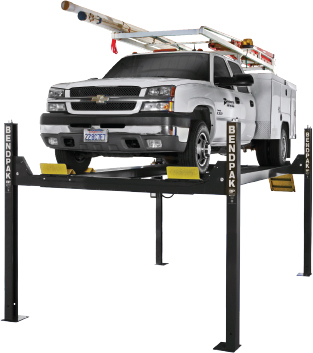How often is lift maintenance needed? Even the most rugged, low-maintenance lifts need attention from time-to-time.
It’s important to give your lift a onceover every day before you use it, check the safety devices, operating controls, lift arms, and all moving parts to make sure everything is functioning properly. Look for breakage, excessive wear, or other conditions that may affect its performance. Be sure to check your adapters—it’s critical to your safety that they’re not damaged, missing their rubber pads, or excessively worn.
Keep an eye and an ear out for any unusual sounds or issues when using your lift. If something doesn’t seem right, stop using the lift until you can get it checked out. Never use a lift if any component is broken or damaged or if you see signs of an oil leak. Call a lift service professional.
Your owner’s manual should lay out the specific maintenance requirements for your lift, but for an overview, here’s the minimum you should do monthly for most two-post and four-post lifts.

MONTHLY CHECKLIST
- Visually inspect all moving parts and all cables for signs of excessive wear.
- Check all arm adjusting locks to make sure they’re operating properly.
- Check all cable connections, bolts, and pins to ensure proper mounting and torque.
- Visually inspect safety locks for proper operation.
- Lubricate posts with grease if required.
- Lubricate locking latch shafts. Push the latch handle/release arm several times for oil to penetrate the pivot points.
- Inspect all anchor bolts and tighten if necessary.
- Check all posts to make sure they are square and plumb.
- Inspect all pivot arm pins to ensure they are properly secure.
- Check cable tension and adjust if necessary.
- If the lift is equipped with an overhead micro-switch, make sure it is operating correctly.
- Check the equalizer cable tension and adjust per the owner’s manual if needed.
- Replace any missing or damaged caution, warning, or safety-related decals. You can order new ones from your lift manufacturer.
If cement anchor bolts are loose or any lift component is found to be defective, do not use the lift. Call a qualified lift service professional to repair it. Never put a lift back into operation until all faulty parts have been replaced with genuine OEM replacement parts. Additionally, always keep your lift and its components clean.
CABLE CARE
A lift inspection isn’t complete without checking your cables. Cables are one of the things you should check before using your lift every day.

LUBRICATE CABLES
The better you take care of your cables, the longer they’ll last. One of the best things you can do is keep your cables lubricated with 85W90 gear oil or ALMASOL® Wire Rope Lubricant. These lubricants get deep into the fibers to protect against wear and damage. Lubricate your cables every three months.
LOOK FOR DAMAGE
Start by relaxing the rope to a stationary position and moving the pick-up points off the sheaves. Clean the surface of the rope with a cloth or wire brush so you can see any breaks.
Flex the cable to expose any broken wires hidden in the valleys between the strands. One way to check for crown breaks is to run a cloth along the rope to check for snags.
Use an awl to probe between wires and strands. Lift any wires that appear loose. Evidence of internal broken wires may require a more extensive rope examination.
Other damage to look for includes abrasive wear, mechanical damage, rotational damage, heat damage, and bending fatigue.
REPLACEMENT TIME
All lifting cables should be replaced every three to five years or when damage is visible. Does that mean every cable that looks “less than brand new” after a couple years of heavy use should be replaced? Not necessarily.
A little wear is to be expected over time. A good rule of thumb is: If, over the course of a single day, you see six random wires sticking out over the length of a single cable (when examining all strands), the entire cable should be replaced. Additionally, if you see three broken wires in just a single strand over the course of a day, you also need to replace the entire cable.
Also replace cables that have worn down by 10% of their original size. For example, if the cable was originally .5 inch in diameter, replace it once it reaches .45 inch. While the difference may seem small, a 14,000-lb rated cable that loses 10% tensile strength will subsequently be rated at just 12,600 lbs. This is a significant reduction in capability when it comes to lifting heavy-duty vehicles.
Cables should also be replaced if they are pitted by corrosion or if there is evidence of kinking, crushing, cutting, bird-caging, a popped core, or heat damage.
If you find damaged cables meeting any of these criteria, replace them immediately. Do not use the lift until the damaged cables have been replaced.
FOR MORE INFORMATION
Find out more about maintaining vehicle lifts, visit www.bendpak.com.




